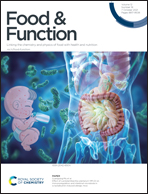DAF-16 acts as the “hub” of astaxanthin's anti-aging mechanism to improve aging-related physiological functions in Caenorhabditis elegans
Abstract
Astaxanthin (AX) is a xanthophyll carotenoid that can effectively inhibit the production of peroxides and thereby protect the body from oxidative damage. In recent years, AX had been shown to have anti-aging properties, both in vivo and in vitro. However, the underlying mechanisms by which AX regulates senescence related proteins and signaling pathways remain unclear. Therefore, we used Caenorhabditis elegans (C. elegans) model binding proteomics to reveal AX anti-aging activity and its molecular mechanism. Our results suggest that AX promotes the health and lifespan of C. elegans by improving mobility, reducing the accumulation of age pigments, and increasing resistance to heat stress. In terms of the underlying mechanism, AX helps prolong the life of worms by regulating AGE-1 in the insulin signaling pathway, promoting the transport of DAF-16 into the nucleus and then up-regulating the expression level of DAF-16's downstream proteins (such as superoxide dismutase [Mn] 2 (SOD-3), heat shock proteins (HSPs), glutathione s-transferase (GST-4), etc.). Furthermore, AX may be a relevant response target for activation of dietary restriction pathways in vivo as a dietary restriction mimic. Meanwhile, proteomics data confirmed that there were 15 proteins enriched in the longevity regulation pathway. AX mainly regulates oxidative stress and the aging process by modulating the insulin signaling pathway around DAF-16 as the “hub”. In addition to the insulin signaling pathway, other pathways including dietary restriction, AMP-activated protein kinase (AMPK), and mammal target of rapamycin (mTOR) are also dependent on DAF-16. These findings expand and deepen our knowledge of the underlying mechanism by which AX extends the lifespan of C. elegans.



 Please wait while we load your content...
Please wait while we load your content...